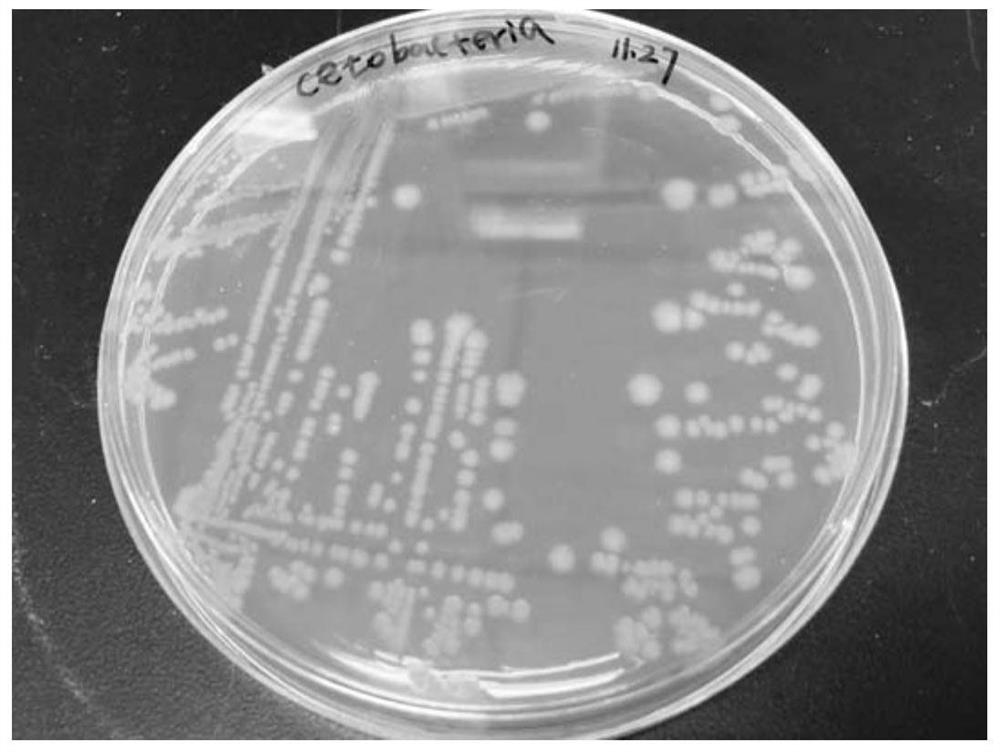A strain of aquatic probiotics with lipid-lowering, anti-inflammatory, anti-apoptotic and anti-viral functions and its application
A technology of fermented products and high-fat feed, applied in the direction of application, bacteria, microorganisms, etc., can solve the problems of unfavorable growth of traditional probiotics such as lactic acid bacteria, susceptibility to disease, dependence, etc.
- Summary
- Abstract
- Description
- Claims
- Application Information
AI Technical Summary
Problems solved by technology
Method used
Image
Examples
Embodiment 1
[0100] Example 1, the acquisition and identification of Cetobacterium somerae XMX-1
[0101] 1. Isolation and purification of XMX-1 bacteria
[0102] In an anaerobic incubator, take the intestinal content of wild-type zebrafish, dilute it with PBS buffer with a concentration of 10mM and a pH value of 7.4, and culture it with ampicillin-resistant (100ug / ml) GAM solid medium for 24 hours, and obtain a single colony , named XMX-1.
[0103] 2. Identification of XMX-1
[0104] 1) Morphological identification
[0105] Observe the growth morphology of the XMX-1 isolated in the above 1 on the ampicillin-resistant (100ug / ml) GAM solid medium.
[0106] The result is as figure 1 As shown, colony size: 2-6mm; round, moist, opaque, light yellow, with irregular edges.
[0107] 2) Physiological and biochemical identification
[0108] The XMX-1 isolated in the above 1 was streak cultured on GAM solid medium, and cultured at 28°C for about 24 hours under anaerobic conditions. Under ste...
Embodiment 2
[0121] Example 2, Under the induction of high-fat feed, the research of Cetella soroi on fish with lipid-lowering, anti-inflammatory and anti-apoptotic functions
[0122] 1. Zebrafish fed with high-fat diet after transfer of Cetella soxleyi
[0123] 1. Germ-free zebrafish high-fat model
[0124] 4 days after fertilization (4dpf, day post-fertilization) 150 (each fish body length is about 4.0-4.2mm; each fish body weight is about 0.6-0.8 mg) sterile Tu strain zebrafish cultured in 500ml GZM culture medium 1. High-fat feed was fed (the amount of high-fat feed was 3-5% of fish body weight per day, 2 times a day; sterile zebrafish were fed ad libitum) for 7 days to establish a sterile zebrafish high-fat model.
[0125] 2. Cetella sordii bacteria liquid and Plasmomonas bacterial liquid
[0126] In the liquid GAM substratum, respectively cultivate the Soxleyeti bacillus XMX-1 and Plasmomonads YZ2 in the embodiment 1, cultivate 12h in the anaerobic incubator at 28 ℃, obtain the Sox...
Embodiment 3
[0163] Embodiment 3, Cetella soxleyi has antiviral function research on fish
[0164] 1. Cetella sordii XMX-1 bacterial liquid or Plasmomonads YZ2 bacterial liquid
[0165] In the GAM liquid culture medium, respectively cultivate the Soxleyeti bacillus XMX-1 and Plasmomonas YZ2 in the embodiment 1, cultivate 12h in the anaerobic incubator for 28 ℃, obtain the Soxleyeti bacillus XMX-1 bacterium liquid (10 8 CFUs / mL) and Pseudomonas YZ2 bacterial solution (10 9 CFUs / mL).
[0166] 2. Carp spring viremia virus
[0167] Using EPC cells (ATCC: CRL-2872) to conduct carp spring viremia virus (SVCV) (the virus is recorded in the following literature: Liu Liyue. Molecular mechanism and proteomics research on the autophagy induced by SVCV infection of EPC cells[ D]. Huazhong Agricultural University, 2014.) Proliferation; EPC cell culture medium is Minimum Essential Media (MEM) medium containing 10% fetal bovine serum, the culture condition is 25 ℃, 5% CO 2 ;
[0168] The specific me...
PUM
 Login to View More
Login to View More Abstract
Description
Claims
Application Information
 Login to View More
Login to View More - R&D
- Intellectual Property
- Life Sciences
- Materials
- Tech Scout
- Unparalleled Data Quality
- Higher Quality Content
- 60% Fewer Hallucinations
Browse by: Latest US Patents, China's latest patents, Technical Efficacy Thesaurus, Application Domain, Technology Topic, Popular Technical Reports.
© 2025 PatSnap. All rights reserved.Legal|Privacy policy|Modern Slavery Act Transparency Statement|Sitemap|About US| Contact US: help@patsnap.com



